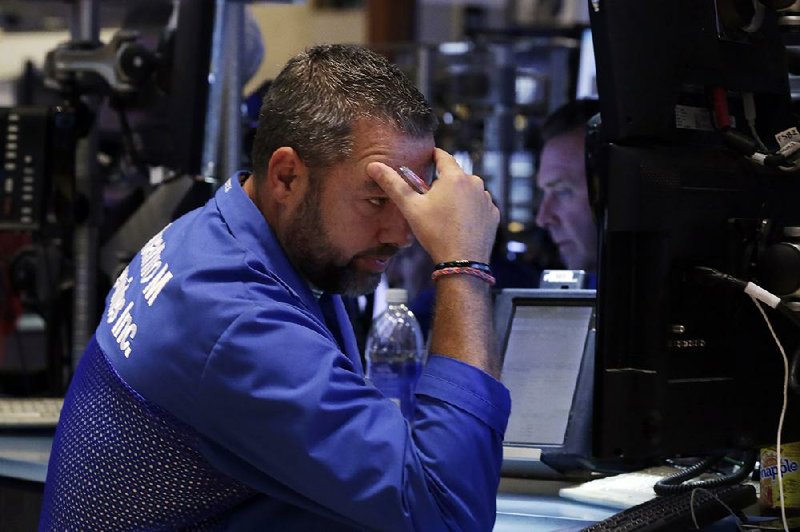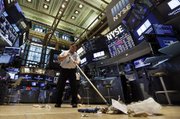NEW YORK -- Stock prices around the world continued to plunge Friday, threatening to end one of the longest bull runs in the history of the U.S. stock market, which saw its biggest daily drop in nearly four years.
The rout started in Asia on concerns about an economic slowdown in China and quickly spread to Europe, battering major markets in Germany and France. In the U.S., the selling started early and never let up.
Investors ditched beaten-down oil companies. Oil plunged below $40 for the first time since the financial crisis, and government bonds rallied as investors moved money into safer places. They also were selling shares of the biggest winners of 2015. Companies that have come to be known as the Fab Five -- Netflix Inc., Facebook Inc., Amazon.com Inc., Google Inc. and Apple Inc. -- saw about $100 billion in market value erased over two days.
By the time it was over, the Standard & Poor's 500 index had lost 5.8 percent for the week, its worst weekly slump since 2011. That leaves the main benchmark for U.S. investments 7.7 percent below its all-time high -- within shooting range of what traders call a "correction," a 10 percent drop from a peak. The Dow Jones industrial average fell 3.1 percent Friday and is now 10 percent off its most recent high.
"This is likely going to go down as the first meaningful correction in four years," said David Rosenberg, an economist and strategist at Gluskin Sheff.
Stock market corrections have historically happened every 18 months. The fact that the U.S. market went nearly four years without one is unusual -- it is the third-longest such streak in the past 50 years, according to JPMorgan Asset Management. Even the most bullish of market strategists will say a correction is ultimately healthy for a market because it removes some of the froth and speculation.
In the coming days, investors will have to decide whether the selling is part of summer squall that will soon pass or the start of tougher times for the global economy that could weigh on stock markets for months.
"There is a relatively more ominous slowdown going on in emerging markets -- and that's what the trade is all about right now," said Gina Martin Adams, an equity strategist at Wells Fargo Securities.
"For much of this year, the glass was considered half full, and now people the last 48 hours are thinking it's looking more empty," George Hashbarger, who oversees $224 million as chief executive officer and portfolio manager at Knoxville, Tenn.-based Quintium Advisors LLC, said by phone.
Markets began falling last week after China announced a surprise devaluation of its currency, the yuan. Investors have interpreted China's move as a sign that flagging growth in the world's second-largest economy could be worse than government reports suggest. On Friday, they got more bad news: A private survey showed another drop in manufacturing on the mainland.
The Standard & Poor's index dropped 64.84 points, or 3.2 percent, to close at 1,970.89. The Dow fell 530.94 points to 16,459.75 and the Nasdaq slid 171.45 points, or 3.5 percent, to 4,706.04.
"Concerns about slowing growth in China are certainly valid," said Jeremy Zirin, head of investment strategy at UBS Wealth Management. "But there doesn't seem to be any signal that the weakness abroad is slipping into the U.S. economy."
Investors pointed to other reasons behind the recent sell-off, such as falling prices for oil and other commodities as well as the relatively high prices investors pay for U.S. stocks compared with corporate earnings.
"All of this is coming at a time when we haven't had a correction since the summer of 2012," Zirin said.
Roberto Perli, head of global monetary policy research at Cornerstone Macro, said the market's recent slump likely means the Federal Reserve won't raise its benchmark interest rate at its September meeting. Fed officials gathering next month will have to weigh the global pressures against evidence of a solid U.S. job market and improving U.S. economic growth.
"They have the luxury of being able to wait and see what happens," Perli said. "But if the meeting was tomorrow, it's probably fair to say that they wouldn't tighten given all the turmoil in the global markets."
If consumers lose confidence because their stock portfolios took a hit, or if companies have to pay more to borrow, economists inside and outside the central bank could start to lower their growth forecasts. And Fed officials' quarterly projections for the path of their benchmark federal funds rate, which will be updated ahead of their Sept. 16-17 meeting, could be lowered as a result of that downward revision.
The question policymakers face in September is "how combustible" financial markets will be if the Fed decides to raise the benchmark rate, said Lou Crandall, chief economist at Wrightson ICAP LLC. "To the extent that global financial conditions are tightening, it is something that feeds into your forecast."
For all the markets' jitters, many economists say they remain confident that the U.S. economy is resilient enough to withstand a slowdown in the developing world. And Europe's economy appears to be emerging from its long slump.
Major markets in Europe finished with deep losses Friday. France's CAC-40 fell 3.2 percent while Germany's DAX lost 2.9 percent. In Britain, the FTSE 100 index dropped 2.8 percent.
In Asia, the Shanghai Composite index suffered another steep drop of 4.3 percent. Japan's Nikkei 225 lost 3 percent, South Korea's Kospi shed 2 percent and Hong Kong's Hang Seng fell 1.5 percent.
U.S. government bond prices rose, pushing the yield on the 10-year Treasury note to 2.04 percent.
In the commodity markets, gold gained $6.40 to settle at $1,159.60 an ounce, while silver slipped 22 cents to $15.30 an ounce. Copper lost 2 cents to $2.30 a pound.
The price of U.S. oil briefly dipped below $40 a barrel for the first time since March of 2009. U.S. crude fell 69 cents to close at $40.45 in New York. At one point, it fell as low as $39.86 in midday trading. Brent crude, a benchmark for international oils used by many U.S. refineries, fell $1.16 to close at $45.46 in London.
Oil prices have tumbled almost 35 percent since this year's highest close in June as producers pump away even after an oversupply pushed prices into a bear market. West Texas Intermediate may drop to $32 on the persisting surplus, Citigroup Inc. said Wednesday. Meanwhile, concern that China's economy will slow increases expectation that demand will wane.
"It's clear that the major producers, the Saudis, Russians, the U.S. and others, are battling for market share," John Kilduff, a partner at Again Capital LLC, a New York-based hedge fund, said by phone.
Information for this article was contributed by Bernard Condon and Matthew Craft of The Associated Press; by Joseph Ciolli, Matthew Boesler, Moming Zhou and Mark Shenk of Bloomberg News; and by Peter Eavis of The New York Times.
A Section on 08/22/2015


